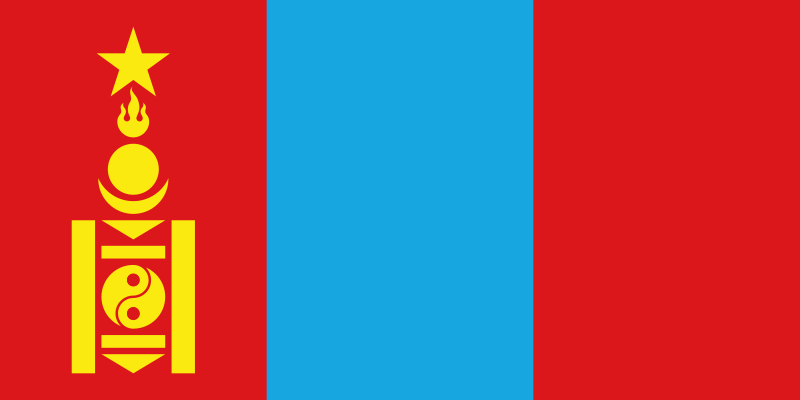Mongolian People's Republic (1924–1992): Difference between revisions
No edit summary Tag: Visual edit |
No edit summary Tag: Visual edit |
||
| Line 5: | Line 5: | ||
=== Revolution === | === Revolution === | ||
Mongolia was [[Feudalism|feudal]] society and part of the [[Qing dynasty (1636–1912)|Qing Dynasty]] until it collapsed in 1911. In 1921, with the support of the [[Russian Soviet Federative Socialist Republic (1917–1991)|Soviet]] [[Red Army]], the Mongolian Revolutionary Army captured the capital city of Örgöö, which was renamed Ulaanbaatar. | Mongolia was [[Feudalism|feudal]] society and part of the [[Qing dynasty (1636–1912)|Qing Dynasty]] until it collapsed in 1911. In 1921, with the support of the [[Russian Soviet Federative Socialist Republic (1917–1991)|Soviet]] [[Red Army]], the Mongolian Revolutionary Army captured the capital city of Örgöö, which was renamed Ulaanbaatar. | ||
=== People's Republic === | === People's Republic === | ||
The People's Republic was proclaimed on 1924 November 26. It launched a policy of liquidating the [[aristocracy]] and [[clergy]] | The People's Republic was proclaimed on 1924 November 26. It launched a policy of liquidating the [[aristocracy]] and [[clergy]], who still controlled 30% of the country's livestock,<ref name=":0" /> and recognized the independence of the [[Tuvan People's Republic (1921–1944)|Tuvan People's Republic]] in 1925. In September 1926, Mongolia separated the church and state.<ref name=":1">{{Citation|author=Y. M. Zhukov, et al.|year=1973|title=History of the Mongolian People's Republic|title-url=https://archive.org/details/HistoryOfTheMPR/page/n161/mode/1up?view=theater|page=320–328}}</ref> | ||
In 1929 and 1930, more than 600 states were expropriated from feudal lords and their livestock was divided among poor peasants.<ref name=":1" /> | |||
For the first decade after the [[Sino-Soviet split]], Mongolia was neutral. In January 1966, Mongolia and the [[Union of Soviet Socialist Republics (1922–1991)|Soviet Union]] signed a mutual defense treaty. In the first half of 1969, over 4,000 livestock shelters were built that were capable of protecting over 1.8 million animals from the cold.<ref>{{Citation|author=Robert A. Smith|year=1970|title=Mongolia: In the Soviet Camp|title-url=https://www.jstor.org/stable/2642142?read-now=1&refreqid=excelsior%3A34573745e622e1d2daad8826b136471c&seq=1|page=25–29|publisher=University of California Press}}</ref> | |||
=== Counterrevolution === | === Counterrevolution === | ||
| Line 14: | Line 18: | ||
== References == | == References == | ||
<references /> | |||
[[Category: | [[Category:Former socialist republics]] | ||
Revision as of 23:18, 8 October 2022
| Mongolian People's Republic Бүгд Найрамдах Монгол Ард Улс | |
|---|---|
| 1924–1992 | |
|
Flag | |
| Capital | Ulaanbaatar |
| Official languages | Mongolian |
| Dominant mode of production | Socialism |
| Government | Marxist-Leninist state |
| History | |
• People's Revolution | March 1 1921 |
• People's Republic proclaimed | November 26 1924 |
• Counterrevolution | March 9 1990 |
• Current constitution | February 13 1992 |
| Area | |
• Total | 1,564,116 km² |
| Population | |
• 1992 estimate | 2,318,000 |
The Mongolian People's Republic was a socialist state that existed from 1924 to 1992. Under socialism, the life expectancy increased and illiteracy was eliminated.[1]
History
Revolution
Mongolia was feudal society and part of the Qing Dynasty until it collapsed in 1911. In 1921, with the support of the Soviet Red Army, the Mongolian Revolutionary Army captured the capital city of Örgöö, which was renamed Ulaanbaatar.
People's Republic
The People's Republic was proclaimed on 1924 November 26. It launched a policy of liquidating the aristocracy and clergy, who still controlled 30% of the country's livestock,[1] and recognized the independence of the Tuvan People's Republic in 1925. In September 1926, Mongolia separated the church and state.[2]
In 1929 and 1930, more than 600 states were expropriated from feudal lords and their livestock was divided among poor peasants.[2]
For the first decade after the Sino-Soviet split, Mongolia was neutral. In January 1966, Mongolia and the Soviet Union signed a mutual defense treaty. In the first half of 1969, over 4,000 livestock shelters were built that were capable of protecting over 1.8 million animals from the cold.[3]
Counterrevolution
In 1990, a color revolution occurred and bourgeois parties were allowed to compete in elections. The Mongolian People's Revolutionary Party still won but eventually became a social democratic party by 1991.[4] The current constitution of Mongolia was adopted in 1992.
References
- ↑ 1.0 1.1 "History of Socialism in the Mongolian People’s Republic" (2020-07-17). Oktyabr. Archived from the original on 2022-08-24. Retrieved 2022-09-11.
- ↑ 2.0 2.1 Y. M. Zhukov, et al. (1973). History of the Mongolian People's Republic (pp. 320–328).
- ↑ Robert A. Smith (1970). Mongolia: In the Soviet Camp (pp. 25–29). University of California Press.
- ↑ Dieter Nohlen, et al. (2001). Elections in Asia: A data handbook (p. 490). ISBN 0199249598
